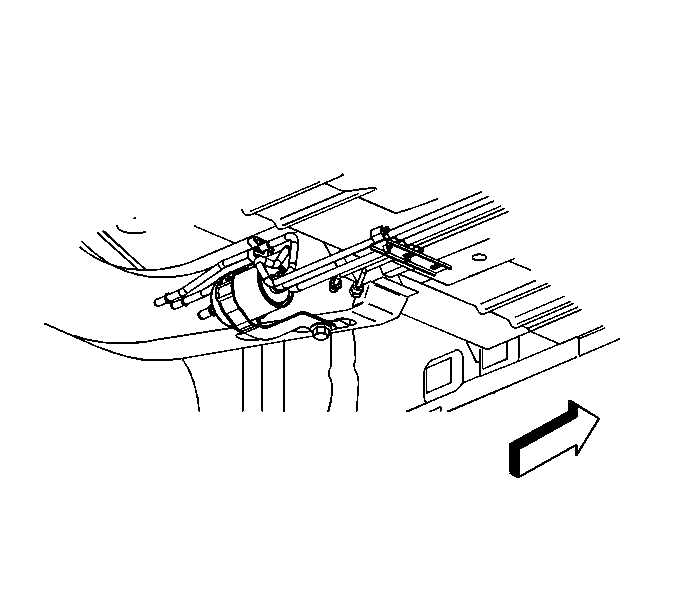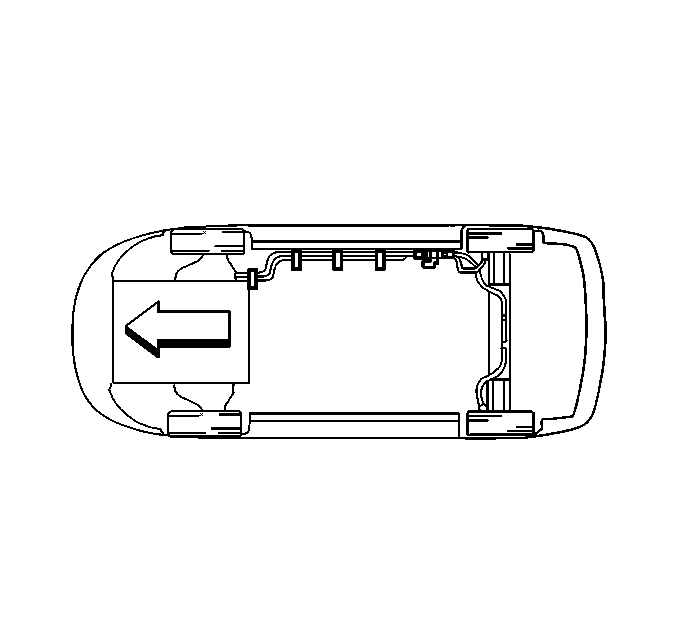Removal Procedure
- Remove the air cleaner intake duct. Refer to Air Cleaner Inlet Duct Replacement .
- Remove the brake master cylinder from the brake booster. Refer to Master Cylinder Replacement in Hydraulic Brakes.
- Relieve the fuel system fuel pressure. Refer to Fuel Pressure Relief .
- Clean all the engine fuel pipe connections.
- Clean the areas surrounding the engine fuel pipe connections.
- Disconnect the quick-connect fittings from the fuel feed and the fuel return pipes in the engine compartment. Refer to Metal Collar Quick Connect Fitting Service .
- Disconnect the evaporative emissions (EVAP) purge pipe quick-connect fitting. Refer to Plastic Collar Quick Connect Fitting Service .
- Raise and support the vehicle. Refer to Lifting and Jacking the Vehicle in General Information.
- Disconnect the quick-connect fitting from the fuel return and the EVAP purge pipes at the fuel filter area. Refer to Plastic Collar Quick Connect Fitting Service .
- Remove the threaded nut fitting from the fuel feed pipe on the engine-side of the fuel filter.
- Cap the following as needed to stop any fuel leakage:
- Remove the attaching hardware from the underbody and the fuel pipe bundle.
- Remove the fuel feed, the fuel return and the EVAP purge pipes from the vehicle.
- Inspect the pipes for bends, kinks and cracks.
- Repair or replace the pipe or pipes as required.

Notice: Cap the fittings and plug the holes when servicing the fuel system in order to prevent dirt and other contaminants from entering the open pipes and passages.
Important: Always maintain cleanliness when servicing the fuel system components.

| • | Fuel filter |
| • | Fuel feed pipe |
| • | Fuel return pipes |

Important: Note the position of the pipes and the attaching hardware for installation.
Notice: Do not attempt to straighten any kinked nylon fuel lines. Replace any kinked nylon fuel feed or return pipes in order to prevent damage to the vehicle.
Installation Procedure
- Install the fuel feed, the fuel return and the EVAP purge pipes to the vehicle.
- Install the attaching hardware to the fuel pipe bundle and the underbody.
- Remove the caps from the following:
- Install the fuel feed pipe threaded nut fitting at the outlet of the fuel filter.
- Connect the quick-connect fittings to the fuel return and the EVAP purge pipes at the fuel filter area. Refer to Plastic Collar Quick Connect Fitting Service .
- Lower the vehicle.
- Connect the EVAP purge pipe quick-connect fitting. Refer to Plastic Collar Quick Connect Fitting Service .
- Connect the quick-connect fittings to the fuel feed and the fuel return pipes in the engine compartment. Refer to Metal Collar Quick Connect Fitting Service .
- Install the brake master cylinder to the brake booster. Refer to Master Cylinder Replacement in Hydraulic Brakes.
- Install the air cleaner intake duct. Refer to Air Cleaner Inlet Duct Replacement .
- Add fuel and install the fuel tank filler pipe cap.
- Connect the negative battery cable. Refer to Battery Negative Cable Disconnection and Connection in Engine Electrical.
- Inspect and ensure that all of the fuel pipe bundle clips and fasteners are properly installed.
- Inspect the fuel system for leaks by performing the following steps:
Caution: In order to reduce the risk of fire and personal injury observe the
following items:
• Replace all nylon fuel pipes that are nicked, scratched or damaged
during installation, do not attempt to repair the sections of the nylon fuel
pipes • Do not hammer directly on the fuel harness body clips when installing
new fuel pipes. Damage to the nylon pipes may result in a fuel leak. • Always cover nylon vapor pipes with a wet towel before using a
torch near them. Also, never expose the vehicle to temperatures higher than
115°C (239°F) for more than one hour, or more than 90°C (194°F)
for any extended period. • Apply a few drops of clean engine oil to the male pipe ends before
connecting fuel pipe fittings. This will ensure proper reconnection and prevent
a possible fuel leak. (During normal operation, the O-rings located in the
female connector will swell and may prevent proper reconnection if not lubricated.)
Notice:
• Do not attempt to straighten kinked nylon pipes. Replace any kinked
nylon pipes in order to prevent damage to the vehicle. • Do not attempt to repair sections of nylon pipes. Replace damaged
nylon pipes. • Replace the vapor pipes with original equipment or parts that
meet GM specifications. • Replace the vapor hoses with original equipment or parts meeting
GM specifications. Use only reinforced fuel-resistant hose identified with
the word Fluoroelastomer or GM 6163M on the hose.
Notice: Always re-attach the fuel lines and fuel filter with all original type fasteners and hardware.
Do not repair sections of fuel pipes.Notice:
• Secure the fuel pipes to the frame in order to prevent chafing.
Maintain a minimum of 13 mm (½ inch) clearance around
a pipe in order to prevent contact and chafing. Maintain a minimum of 19 mm
(¾ inch) around any moving part. • Do not allow the fuel pipes to come into contact with the fuel
tank or underbody.

Important: If fuel line bundle attaching hardware is damaged or broken replace the hardware.

| • | Fuel return pipe |
| • | Fuel filter |
Notice: Use the correct fastener in the correct location. Replacement fasteners must be the correct part number for that application. Fasteners requiring replacement or fasteners requiring the use of thread locking compound or sealant are identified in the service procedure. Do not use paints, lubricants, or corrosion inhibitors on fasteners or fastener joint surfaces unless specified. These coatings affect fastener torque and joint clamping force and may damage the fastener. Use the correct tightening sequence and specifications when installing fasteners in order to avoid damage to parts and systems.
Tighten
Tighten the threaded nut fitting to 30 N·m
(22 lb ft).

| 14.1. | Turn ON the ignition for 2 seconds. |
| 14.2. | Turn OFF the ignition for 10 seconds. |
| 14.3. | Turn ON the ignition. |
| 14.4. | Inspect for fuel leaks. |
